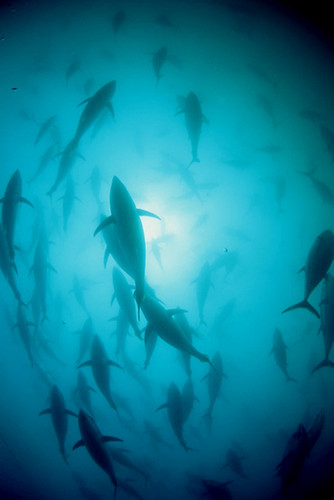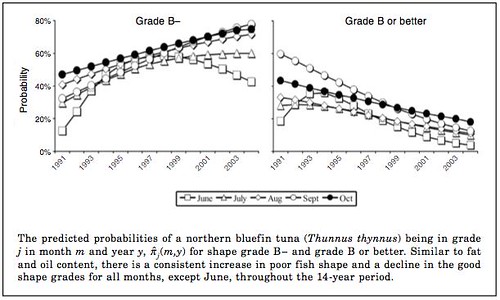tags: researchblogging.org, bluefin tuna, Thunnus thynnus, fishing, fishery, overfishing, sushi
The western Atlantic Bluefin Tuna fishery in the Gulf of Maine is in danger of collapse, according to University of New Hampshire (UNH) researchers. Further, the team found that the number and quality of the captured fish has declined markedly in recent years.
Using notes collected by veteran tuna grader Robert Campbell from the Yankee Fisherman's Co-op in Seakbrook, New Hampshire, Walter Golet led a team of marine biologists that analyzed the quality of 3,082 Atlantic bluefin tuna, Thunnus thynnus.
"In a drawer, he had two or three notebooks with every fish he graded in the last 14 years, from 1991 through 2004," said Golet, who is a PhD candidate in UNH's Large Pelagics Research Lab.
Tuna are awarded different grades, with A being the highest grade possible, based on their fat and oil content and on their overall body shape.
According the team's analysis of fat and oil content, the probability of landing a C+ fish in 1991 was 16 percent and 9 percent for August and September, respectively. However, by 2004, the probability of tuna being graded in the C+ category for August and September increased to 68 percent and 76 percent, respectively (Figure 1, below).
"Fat content is in high demand for the market, because that's what makes the meat taste good," stated Golet, noting that fish with well-marbled tail meat, fat in their mid-section muscle and belly, and a rotund shape can command upwards of $50 per pound on the sushi market.
The team also found that bluefin tuna are leaner when they arrival in the Gulf of Maine (figure 2, below). The probability of catching a fish with a lean body type (grade C or worse) in June 1991 was 30% compared with 70% in 2004. Good quality fish, those with rounded bodies that are graded as B or better, now comprise less than one percent of the commercial catch at the Yankee Fisherman's Co-op.
Unfortunately, the team's findings confirm numerous observations by fishermen and fish brokers throughout the years that there are fewer tuna being caught in the western Atlantic and the captured fish have poorer body condition, which makes them fetch lower prices on the open market. However, this decrease in overall body fat is more important than simply worrying about the taste of the fish: it also has important implications for reproduction and for the long-term survival of the species.
"One of the big consequences of not fattening as much is the potential impact it could have on reproduction," Golet explained. "Reduced energy stores can often force a fish to skip spawning in a particular year."
Bluefin tuna are a highly migratory pelagic species whose spawning grounds are located in the Gulf of Mexico and in the Mediterranean Sea. Due to their migratory ways, they have high energy demands so this reduction in fat stores could affect their migration patterns. Even though the bluefin tuna's seasonal movements are poorly known, there is mounting evidence suggesting that their migration is more complex than once thought. For example, many bluefin tuna may be traveling long distances to reach the Gulf of Maine. In fact, some tagged fish were discovered to have traveled from the central and eastern Atlantic Ocean, which results in far greater than expected energy demands because they are swimming greater distances against stronger currents.
Further, UNH researchers documented a dramatic decline in overall numbers of the fishes: in the mid-1990s, they recorded between 500 to 900 schools of bluefin tuna in the Gulf of Maine, each averaging 100 to 150 fish each, said Molly Lutcavage, a co-author of the study and director of UNH's Large Pelagics Research Center. She said only a "few" schools would be seen in today's waters.
What is causing this dramatic decline in bluefin tuna numbers and quality? Many on the Western side of the Atlantic claim that overfishing by Eastern Atlantic and Mediterranean fisherman is responsible for the decline. The Western Atlantic's bluefin quota is only about 2,500 metric tons per year, while the Eastern's is more than 10 times that, with many fisherman catching even more fish than that, Lutcavage said, decreasing populations stateside. But the evidence suggests that there are likely other factors contributing to the tuna's decline.
For example, even though stock assessments of herring, which comprise the bulk of the tuna's diet, show that the populations of this fish are at historically high levels, the herring might have experienced a decline in quality as well, or maybe they dispersed into smaller schools, thus requiring a greater energy output to locate. There also is the so-called "junk food hypothesis" that proposes that changes in tuna diet from high-energy food like herring and mackerel to less energetic species like haddock or sand lance results in lower caloric intake, and thus, poorer body quality as well as lower survival rates in tuna. Irregardless, the source of the tuna's problems is not immediately obvious.
"I'm very convinced that it's multiple factors working with each other," observes Golet.
Sources
Walter J. Golet, Andrew B. Cooper, Robert Campbell, Molly Lutcavage (2007). Decline in condition of northern bluefin tuna (Thunnus thynnus) in the Gulf of Maine Fisheries Bulletin, 105 (3), 390-395 [free PDF].
University of New Hampshire press release (quotes).
SunJournal (quotes).
You should also read this story that describes how 90% of the oceans' large fishes have disappeared.




"Irregardless, the source of the tuna's problems is not immediately obvious."
Apart from us of course ;-)
Great post Grrrl,
I am continually amazed that nothing gets down about the problem. The evidence has been pouring in since I've been a marine biologist which is only about 5 years or so. But it has been systematically ignored, now we will have nothing but plankton and Jelly Burgers to eat! And anyone that seen Soylent Green knows what happens when we eat "plankton burgers"...
I'm a ringside spectator to the ongoing collapse of the North Sea cod stocks, and I see the same thing happening all over the world. One of the problems is that politicians get so wrapped up in "winning concessions" for the fishing lobby that they have no interest in a bigger or more long-term picture, and many people in the fishing industry seem to be either in complete denial over the extent of the problem, or they recognise that the fisheries are on their way out, but they see this as being completely inevitable and just want to grab as much profit for themselves as they possibly can before it's all gone. It's incredibly depressing, on a lot of levels.
Too few people know that Northern Europe once had ample stocks of blue-fin tuna. The shoals were so big, that the ferries crossing the Ãresund between Denmark and Sweden had special right-of-way rules to avoid damage.
The stocks were largely fished out in 1955, when landings dropped from 2'000 tons to 20 tons and less.
One suspected reason was the increased industrial fishing for herring and other small fish that tuna prey on.
Natural Sciences Carnival 2nd edition is up here and your submission was selected.
Thanks for your submission! Spread the word!
I know it's not much but this concept may offer some hope yet:
http://www.sciam.com/article.cfm?articleID=0058EF3E-E7F2-99DF-3C2EC5A22…
" Yoshizaki says.
But the real target of the effort is Japan's favorite fish: the bluefin tuna. The fastest fish in the sea (and one of the largest) has been rapidly declining due to overfishing but its size and habits make it difficult to raise in captivity. "If we can produce surrogate mackerel, whose body size is 500 to 1,000 grams--nearly 1,000 times smaller than tuna--we can save space, cost and labor to produce [a] tuna baby," Yoshizaki says. And that means humanity won't have to worry about a big species of fish that got away.
BTW, until then, I for one am still worrying.
I had begun noticing that my local supermarket has stopped having an ample supply of Tuna Sushi rolls, so I inquired about it and was told that it was getting prohibitively expensive for them to purchase the Tuna. I myself have stopped ordering tuna at the restaurants that I frequent. A little wasabe and soy sauce go a long way to spice up some of the other options that are offered. As much as I like the taste of tuna I think I can do without and do my small part to help conserve this spectacular fish.
The other thing that comes to mind is something I read (can't remember where), about transgenic fish, I'm pretty sure it isn't possible as yet to produce tuna muscle in a Tilapia. Does anyone know anything about research dealing with this?
This is depressing. And tuna tastes so good. I guess I'll give it up if it means getting their stocks up to the level where my grandchildren can enjoy it someday.